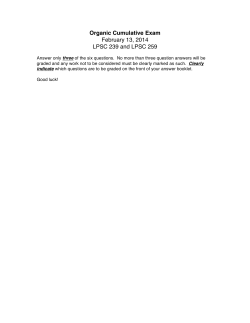
Completing Chemical Reactions
Completing Chemical Reactions If you only know the reactant(s) in a reaction, you can predict what products will form! Each type of reaction has a specific pattern. Use this to help you! Steps to follow 1. Identify Reactant(s) 2. Identify Reaction Type 3. Predict the products using the rules for the specific reaction type ◦ If the new products are ionic, you MUST do a new “criss cross” to determine the formula of the new compound(s) 4. Balance the Equation 1. Synthesis Reactions (a) Metal + non-metal Ionic compound ◦ Combine the two elements into a compound ◦ Use criss-cross rule to determine formula of new compound! Ex: Li + Cl2 Ex: Al + O2 (b) non-metal + non-metal molecular compound ◦ Simply combine the two elements into a compound, leaving the subscripts the same. Ex: S + Br2 Ex: C + O2 2. Decomposition Reactions A. Binary compounds o Compound element + element o Break down into their two elements (HOFBrINCl still applies!) Ex: H2O Ex: MgCl2 B. Carbonates o When a compound with carbonate (CO3) in it decomposes, Carbon dioxide is ALWAYS formed o The other compound is a metal oxide (compound containing the metal and oxygen) Ex: MgCO3 Ex: Na2CO3 3. Single Displacement Reactions o The two metals switch places OR the two non-metals switch places o MUST do a new criss-cross on the new compound!! DO NOT just carry over the subscripts o If a multivalent metal exists, determine its charge from the reactant formula Ex: Mg + CuCl2 Ex: KBr + l2 4. Double Displacement Reactions A. Precipitation Reactions o Two aqueous compounds combine and form a solid product (precipitate) in a solution o Switch the cations between the two compounds o Do new criss-crosses to determine new formulas! Ex: NaCl + BeO Ex: KI + Pb(NO3)2 5. Combustion Reactions A. Complete combustion of a hydrocarbon o Two products are always CO2 and H2O Ex: Complete combustion of C6H14 (hexane – used in shoe glue) Practice: + O2 → 1. Ag 2. Na2S + Cl2 → 3. CaO + KCl → 4. HgO → 5. CaCO3 6. Al 7. C2H6 + + → FeO → O2 →
© Copyright 2025





















